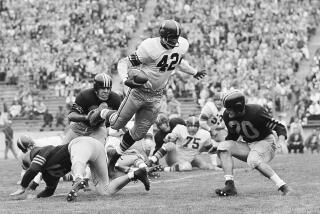A Physician Tries to Beat the Odds as Patients With AIDS Keep Coming
- Share via
On a wall in family practitioner Charles A. Robertson’s medical office hangs a cartoon penned by a former patient.
“Born to Heal!” it says, over a caricature of a zealous but cheerful “Dr. Chuck,” balancing three medical books and rushing to a hospital, a small puff of smoke at his heels.
Like many young doctors, Robertson, 35, is a busy man. He rises at 5 to read medical journals and study the latest research on a computer at his Lido Island home. From 9 a.m. to 6 p.m. he sees patients in his comfortably furnished Costa Mesa office. On especially busy days, he also swings by one of the two drug-and-alcohol rehabilitation programs--Starting Point of Orange County and the Hoag Memorial Hospital Presbyterian Chemical Dependency Unit--for which he serves as assistant medical director.
After the office work, Robertson must still make the rounds of patients at Hoag Hospital before heading home for a late dinner and possibly a walk on the beach.
But for all Robertson’s energy and seemingly boundless cheer, there is an air of sadness about him. For many of his patients are dying young.
Like most family doctors, Robertson sees a mix of patients--mostly couples and single professionals in their 20s to 40s who get colds and the flu. But Robertson also has a specialty he never bargained for: patients with acquired immune deficiency syndrome.
Since 1980, when he began working at the county’s clinic for sexually transmitted diseases, as well as starting a private practice, about 150 of his patients have had the deadly disease.
As word has spread that Robertson is one of just a few doctors who regularly cares for AIDS patients, newly diagnosed victims often seek him out; by now, fully 25% of the county’s 595 AIDS patients have been Robertson’s.
“Tom Prendergast (the county epidemiologist) always accuses me of having more patients with AIDS in my practice than most states do,” Robertson said.
Of 357 county residents who have died from AIDS, Robertson has tried in vain to save 50-70 of them. Among the AIDS victims he has treated were Devron Huber, who wrote a newspaper diary about fighting the disease, and Bob Riddell, the man who drew the “Dr. Chuck” cartoon.
Robertson said he doesn’t try to keep track of the deaths, but “sometimes I stop and reflect on who they were--all live, walking, talking individuals who are no longer there. . . . I get real frustrated sometimes.”
A frown creases his round, friendly face. “Right now I probably see one new (AIDS) case a week and a new HIV-positive individual a day,” he said about patients who have antibodies associated with AIDS but who have no other signs of the deadly virus.
On a “slow day,” Robertson calculated that he usually sees four AIDS patients a day. But one recent Thursday--the day he treats AIDS patients with an aerosol spray--he saw 13. “That was a bad day,” he recalled.
But then it is a bad disease: “It affects young, healthy people. If they get (otherwise) sick, you usually can fix them.”
But with the young people who contract AIDS, “in spite of everything you can do, you can’t fix them.”
Still, Robertson tries hard to beat the odds. When a new drug is available, he makes sure his patients have it.
For all the pain, Robertson finds this practice rewarding. AIDS patients, he said, are very well read, cooperative--very concerned about their health.
He worries about them, though. Some of the attorneys and teachers he sees are still trying to work and “running themselves ragged. . . . They are reluctant to look at themselves as ill and are not willing to slow down.”
Robertson, who is still hoping to lick this disease, isn’t willing to slow down, either. He regularly attends international conferences on AIDS and, in his spare time, is an honorary board member on the AIDS Services Foundation, which provides support services for AIDS patients, and on the steering committee of a group trying to start a county hospice.
Robertson said his other patients sometimes worry about whether they might contract AIDS at his office. The disease is spread by intimate sexual contact or shared intravenous needles, not casual contact. But that doesn’t stop some people from worrying.
“One elderly lady with diabetes asked me, ‘Doctor, am I going to get this disease?’ ” at Robertson’s office. “I told her ‘no.’ She still comes back to see me.”
Herbert J. Vida is on vacation
More to Read
Sign up for Essential California
The most important California stories and recommendations in your inbox every morning.
You may occasionally receive promotional content from the Los Angeles Times.










